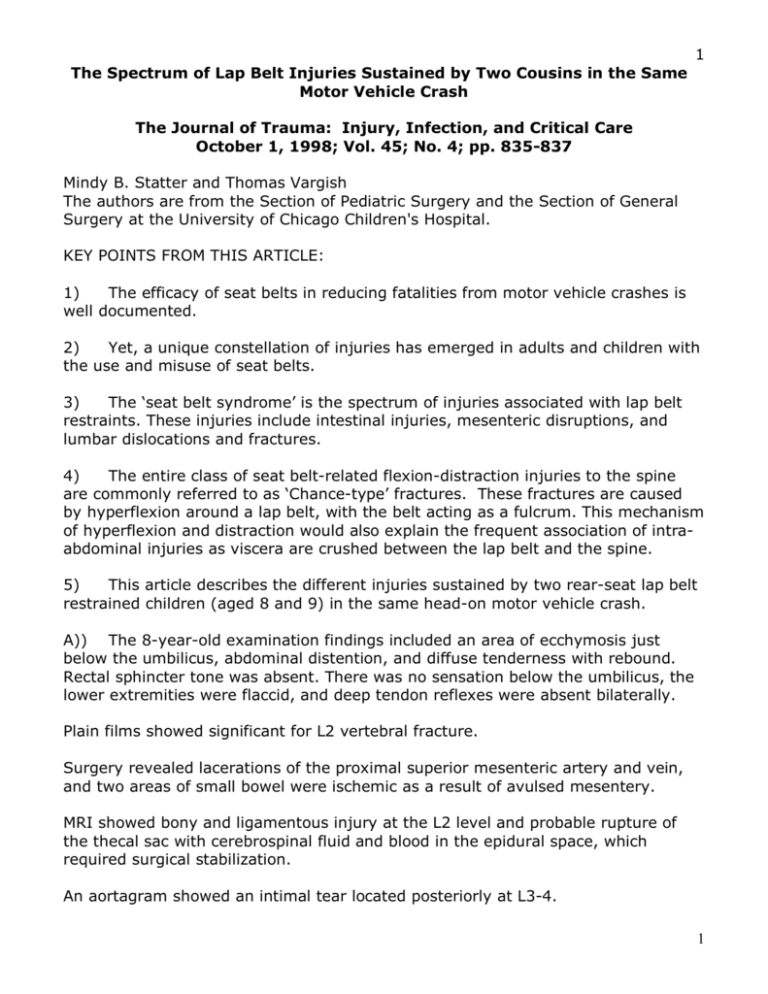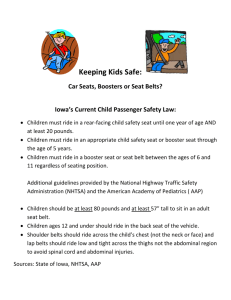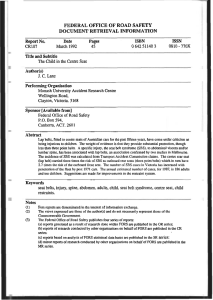AR 09-99.statter.LAP BELT
advertisement

1 The Spectrum of Lap Belt Injuries Sustained by Two Cousins in the Same Motor Vehicle Crash The Journal of Trauma: Injury, Infection, and Critical Care October 1, 1998; Vol. 45; No. 4; pp. 835-837 Mindy B. Statter and Thomas Vargish The authors are from the Section of Pediatric Surgery and the Section of General Surgery at the University of Chicago Children's Hospital. KEY POINTS FROM THIS ARTICLE: 1) The efficacy of seat belts in reducing fatalities from motor vehicle crashes is well documented. 2) Yet, a unique constellation of injuries has emerged in adults and children with the use and misuse of seat belts. 3) The ‘seat belt syndrome’ is the spectrum of injuries associated with lap belt restraints. These injuries include intestinal injuries, mesenteric disruptions, and lumbar dislocations and fractures. 4) The entire class of seat belt-related flexion-distraction injuries to the spine are commonly referred to as ‘Chance-type’ fractures. These fractures are caused by hyperflexion around a lap belt, with the belt acting as a fulcrum. This mechanism of hyperflexion and distraction would also explain the frequent association of intraabdominal injuries as viscera are crushed between the lap belt and the spine. 5) This article describes the different injuries sustained by two rear-seat lap belt restrained children (aged 8 and 9) in the same head-on motor vehicle crash. A)) The 8-year-old examination findings included an area of ecchymosis just below the umbilicus, abdominal distention, and diffuse tenderness with rebound. Rectal sphincter tone was absent. There was no sensation below the umbilicus, the lower extremities were flaccid, and deep tendon reflexes were absent bilaterally. Plain films showed significant for L2 vertebral fracture. Surgery revealed lacerations of the proximal superior mesenteric artery and vein, and two areas of small bowel were ischemic as a result of avulsed mesentery. MRI showed bony and ligamentous injury at the L2 level and probable rupture of the thecal sac with cerebrospinal fluid and blood in the epidural space, which required surgical stabilization. An aortagram showed an intimal tear located posteriorly at L3-4. 1 2 B)) The 9-year-old examination revealed ecchymosis lateral to the umbilicus, abdominal distention with diffuse tenderness, and an obvious deformity of the left wrist. Plain films were significant for a left distal radius fracture. Operative findings showed lacerations of the distal superior mesenteric artery and vein, and four segments of the small bowel were ischemic as a result of avulsed mesentery. No significant spinal injuries were found. 6) “Four to-9-year-old children are a special group with respect to motor vehicle occupant restraint systems. These children have outgrown the child safety seats designed especially for younger children and are restrained in seat belts designed for adults.” 7) 4 to 9-year-old children differ from adults in three ways: A)) The intra-abdominal organs are less protected by the bony thorax and pelvis. B)) The iliac crests are not adequately developed to serve as anchor points for the belt, thus allowing it to ride up over the abdomen. C)) With rapid deceleration, a greater proportion of body mass lies above the lap belt, allowing ‘jackknifing’ over the lap belt to occur, with compression and injury of the abdominal viscera, as happened to these two children. 8) The intraperitoneal, aortic, and spinal injuries sustained by the 8- and 9-year old children in this report are attributable to the mechanism of hyperflexion and distraction around the fulcrum of a seat belt restraint. 9) “The hallmark indicator of the seat belt syndrome is abdominal wall ecchymosis, suggesting the pattern of a lap belt.” 10) “Many children with abdominal injury caused by blunt trauma have either equivocal or absent physical findings.” 11) The use of CT to evaluate blunt abdominal trauma in children is routine in many trauma centers, and is excellent for evaluating solid organ injuries but is unreliable for the detection of hollow visceral injuries. 12) Both of these children demonstrated crush injuries to the small and large intestine as well as shear injuries to the mesentery. 13) Paraplegia has been reported in a seat belt-restrained child with spinal cord injury without radiographic abnormality. “It has been noted that the more hypermobile, elastic, and deformable pediatric spine might sustain [neurological] injury without disrupting bone or ligaments as it responds to a traumatic force. 2 3 Pediatric patients in motor vehicle crashes with unexplained extremity pain warrant full spinal evaluation, even with normal plain radiographs.” 14) “Blunt aortic injury is attributed to direct aortic compression between the spine and the lap belt during deceleration.” 15) Lap belt injured patients should be examined for vascular or neurologic deficit followed by imaging studies: CT, ultrasonography, and arteriography. 16) “These two children demonstrate that, with the common mechanism of seat belt compression with hyperflexion and distraction during deceleration, there should be a high index of suspicion for the complete spectrum of intra-abdominal, aortic, and spinal injuries in restrained pediatric passengers in motor vehicle crashes. The high index of suspicion should be applied not only to the management of children presenting acutely after motor vehicle crashes but also to those children presenting with signs and symptoms of intestinal obstruction after previous seat belt-related blunt abdominal trauma. Delayed presentation of traumatic intestinal structures has been reported.” 17) Back seat restraints need to include shoulder cross-straps and the ability to adjust them to fit smaller individuals, including children. 18) “These children were properly restrained in the back seat with lap belts only (the vehicle was not equipped with shoulder harnesses). Adult seat belts should not be considered to provide equivalent protection as child safety or booster seats.” COMMENTS FROM DAN MURPHY: This article is another example of the principle that lap belts alone are not adequate protection for children between the ages of 4-10. Lap belts alone increase the probability of belt fulcrum trauma for children in this age group. I believe that the most important statement in this article is that children, because of their increased elasticity, are less likely to suffer traditional soft tissue injures, but are rather more likely to suffer neurological injury. 3






